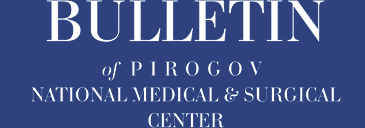Authors
Levchuk A.L.1, Abdullaev A.E.2
1 Pirogov National Medical and Surgical Center, Moscow
2 GKB SMP, Vladimir
Abstract
The aim of the study was to evaluate the results of diagnosis and treatment of patients with diverticular colon disease (DBTC), complicated by perforation into the free abdominal cavity, with the development of widespread peritonitis.
Materials and methods. 115 patients were treated in the State Clinical Hospital of the NSR of Vladimir from 2014–2024 with DBTC complicated by widespread peritonitis. There were 72 men (62.6%) and 43 women (37.3%). The average age of the patients was 56.2±11.3 years. Ultrasound of the abdominal cavity was performed in 92 (80%) patients, abdominal X-ray in 85 (73.9%) cases, CT of the abdominal cavity in 32 (27.8%) patients, diagnostic endovideolaparoscopy was performed in 25 (21.7%) patients. All patients were operated on. The fatal outcome was recorded in 10 (9%) cases.
Results: 38 (33%) patients were admitted within 24 hours of the disease, 54 (47%) 24–72 hours and 23 (20%) more than 72 hours. In 65 (57%) ultrasound observations, sigmoid diverticula were detected. In 43 (38%) patients, there is free gas in the paracollar tissue. In 25 (22%) cases, blurring of the outer contour of the diverticulum was noted. In 15 (13%) patients, free gas was diagnosed on abdominal X-ray. The most effective diagnostic methods for this pathology were: MSCT and diagnostic laparoscopy, which in 98% of cases allowed to establish the correct diagnosis. Obstructive resection of the sigmoid colon according to Hartmann was performed in 71 (62%) cases. Complications occurred in 2 (2%) cases. Mortality in this subgroup is 5 (5%) patients. Obstructive resection of the descending intestine according to the Hartmann type was performed in 15 (13%) patients. There were no complications in this subgroup. Left-sided hemocolectomy with a single-stem colostomy was performed in 6 (6%) cases. Complications occurred in 2 (2%) patients. Obstructive resection of the sigmoid colon according to Hartmann + laparostomy was performed in 15 (13%) cases. In 7 (6%) cases, a vacuum-assisted laparostomy was formed after the main stage of the operation. 4 (4%) patients had a fatal outcome. Left-sided hemicolectomy with single-stem colostomy+laparostomy was performed in 8 (6.9%) patients. In 3 (2.6%) cases, a vacuum-assisted laparostomy was formed. In 1 (0.8%) case, a fatal outcome occurred against the background of progression of multiple organ failure, abdominal sepsis and septic shock.
Conclusion: The complicated course of DBTC has become the most important problem of urgent surgery. The issue of the treatment of patients with perforation of the diverticula of the colon in conditions of widespread peritonitis and severe abdominal sepsis remains relevant. The greatest diagnostic value in this category of patients are: computed tomography with intravenous contrast and diagnostic laparoscopy. Obstructive resection of the colon with perforation of the diverticulum is the operation of choice for widespread purulent and fecal peritonitis, which allows to eliminate the source of peritonitis, sanitize the abdominal cavity and reduce the degree of intoxication of the body. including in severe, comorbid and gerontological patients.
Keywords: diverticular disease of the colon, perforation of the diverticulum of the colon, common peritonitis.
References
1. Ardatskaya MD, et al. Diverticular disease. Coloproctology. 2021; 20(3): 10-27. (In Russ.) doi: 10.33878/2073-7556-2021-20-3-10-27.
2. Bolikhov KV. Acute inflammatory complications of diverticular colon disease (clinic, diagnosis, treatment). [abstract. dis.] M.; 2006. (In Russ.)
3. Vorobyov GI, Salamov KN, Achkasov SI. Determination of the boundaries of colon resection in diverticulosis. Surgery. 2001; 1: 80-86. (In Russ.)
4. Timerbulatov VM, Fayazov ShF, Temirbulatov ShF. Experience in the treatment of acute diverticulitis of the colon. Medical Bulletin of Bashkortostan. 2009; 3: 54-58. (In Russ.)
5. Kabanov MY, Glushkov NI, Levchuk AL. Surgical gastroenterology in elderly and senile patients. М, 2021. 448 р. (In Russ.)
6. Greenberg AS, Gal R, Coben RM, et al. A retrospective analysis of medical or surgical therapy in young patients with diverticulitis. 2005; 21(10): 1225-1229.
7. Shelygin YuA, Achkasov SI, Moskalev AI. Laparoscopic access in the planned surgical treatment of diverticular disease. Coloproctology. 2014; 4(50): 5-13. (In Russ.)
8. Nakaji S, Danjo К, Munakata А, Sugavarа К, et al. Сomparison of etiology of right-sided diverticula in japinees elevatoring diverticulum on the West. Int J kolorektal’nogo Dis. 2002; 17: 365-373.
9. Pittet O, Kotzampassakis N, Schmidt S. Recurrent left colonic episodes: more Severe than the initial diverticulitis? World J Surg. 2009; 33(3): 547-552.
10. Shelygin YuA, Ivashkin VT, Achkasov SI, Moskalev AI, et al. Сlinical guidelines Diverticular disease (57.2, 57.3), adults. Koloproktologia. 2024; 23(2): 10-27. (In Russ.) doi: 10.33878/2073-7556-2024-23-2-10-27.
11. Gostischev VK, Sazhin VP, Avdovenko AL. Peritonitis. M.: GEOTAR-MED., 2002; 240. (In Russ.)
12. Aliyev FSh, Tamrazov RI, Aliyev VF, et al. Compression delayed anastomosis in surgical treatment of complicated diverticular colon disease. Medical Bulletin of Bashkortostan. 2023; 3: 42-48. (In Russ.) doi: 10.33878/2073-7556-2021-20-4-42-48.
13. Gibert BK, Matveev IA, Borodin NA, et al. Аctual clinical approach for complicated diverticular disease in general surgery department. Koloproktologia. 2018; 2: 54-58. (In Russ.) doi: 10.33878/2073-7556-2018-0-2-54-58.
14. Karpukhin OYu, Pankratova YuS, Cherkashina MI, et al. Сomplicated diverticulitis: management, diagnosis, treatment. Koloproktologia. 2018; 2: 68-72. (In Russ.) doi: 10.33878/2073-7556-2018-0-2-68-72.
15. Shapovalyants SG, Lindenberg AA, Bolikhov KV, Shulaev AV. Colon resection is the most effective solution for diverticular disease complicated by peritonitis. Moscow Surgical Journal. 2018; 3: 25. (In Russ.)
16. Zabelin MV, Zubritskiy VF, Levchuk AL. Intraperitoneal hypertension. M.: Viva-Star, 2020: 143 р. (In Russ.)
17. Linder MM, Washa H, Feldmann U, Wesch G. Der Mannheimer Peritinitis-Index. An instrument for intraoperative prognosis of peritonitis. Der Chirurg; Zeitschrift fur alle Gebiete der operative Medizen. 1987; 58(2): 84-92.
18. Vincent J-L, Opal SM, Marshall JC, et al. Sepsis definitions: time for change. Lancet. 2013; 381: 774-775.


